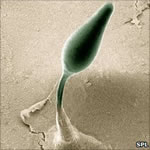 The amoeba species Dictyostelium discoideum slime mold (or dicty, as scientists lovingly call it) is one fascinating organism. For instance, its life cycle involves unicellular amoeba, then a multicellular slug that scoots around to find food, then a "fruiting body" to disperse spores to new growing areas.
The amoeba species Dictyostelium discoideum slime mold (or dicty, as scientists lovingly call it) is one fascinating organism. For instance, its life cycle involves unicellular amoeba, then a multicellular slug that scoots around to find food, then a "fruiting body" to disperse spores to new growing areas.Scientists have just discovered that the slime mold is even cannier than previously thought: it can also "farm."
Research described in Nature shows that a third of these spores contain some of the bacteria to grow at the new site.
Food management has been seen in animals including ants and snails, but never in creatures as simple as these.
The behaviour falls short of the kind of "farming" that more advanced animals do; ants, for example, nurture a single fungus species that no longer exists in the wild.
But the idea that an amoeba that spends much of its life as a single-celled organism could hold short of consuming a food supply before decamping is an astonishing one.
More than just a snack for the journey of dispersal, the idea is that the bacteria that travel with the spores can "seed" a new bacterial colony, and thus a food source in case the new locale should be lacking in bacteria.

No comments:
Post a Comment